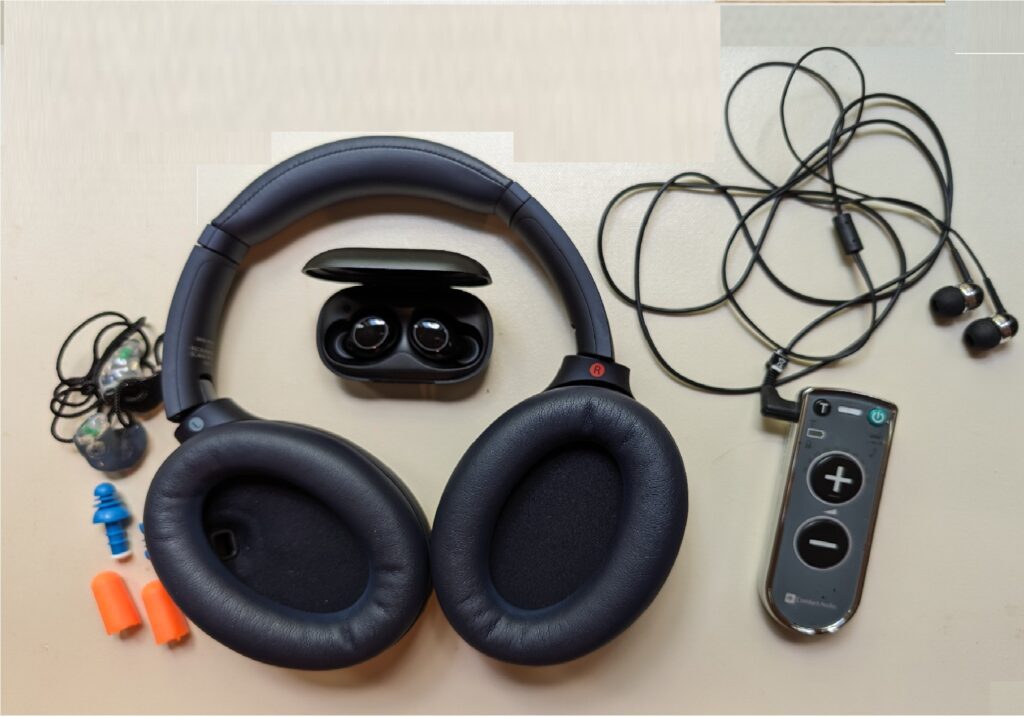Assistive Listening Devices (ALDs) and Technology for Hearing Loss

Hearing help is not limited to hearing aids. Many people use an array of assistive listening devices to boost communication and hearing anytime and anywhere. Although required by the ADA (Americans with Disabilities Act) hearing accommodation in public places is at best spotty and not very well publicized. And so, I don’t travel without my kit of hearing accessories – both wired and wireless – because one never knows what to expect. (See picture above)
It is often said that Assistive Listening Devices (ALDs) and technology systems are the workhorses in the World of Hearing Loss. whose value and versatility must not be underestimated. They introduce people to the benefits of basic hearing technology. They support those who feel the need for help but who are not ready for hearing aids. They rescue those who are mired in denial by proving that any kind of better hearing is a huge improvement over what they have. Depending on the case, devices such as wireless assistive microphones can boost the range and efficiency of hearing aids.
To Hear or not to Hear is for the individual to decide
Although all sorts of assistive listening help is available, there are those who feel that it is not for them because the devices are visible. However, in the case of hearing struggles, communication access and quality of life are at stake. So, how important is it to be connected and included in conversations and activities? That is a personal decision that one must make for oneself.
After many years of being an avid Bridge player, my mother-in-law quit her Bridge Club. She misunderstood bids and became a liability for her team. She admitted to her hearing struggles but flatly refused to get hearing aids. After giving her some time to think about it, we suggested that she might try an assistive device. At home, without anybody knowing. Yes, it would be visible, but it could allow her to continue playing Bridge and seeing her friends. Eventually, she accepted a Pocketalker with headset and ended up loving it. She found all sorts of listening & communication uses for the device and declared herself as “going high-tech” with connecting earbuds.
Mom made up her mind that getting out was more important than worrying about a visible assistive set. It took courage but she got her priorities straight and I always admired her for that. Her friends congratulated her on being back. And so she was, by her own choice!
A huge, chaotic and ever-changing market
Assistive hearing choices are overwhelming. Pages and pages of Google results boggle the mind. There are those for daily living and safety, such as amplified watches, alarms and phones; captioned phones; bed shakers; signaling devices for doorbells, alarms, weather alerts and baby monitors. There are those that ease entertainment: TV soundbars; special TV listening devices and streamers, earbuds and headsets for connecting wirelessly to TV, laptop or computer.
I love my noise-reducing headphones. They have been tremendously helpful to me, and I wish there was a hearing aid version of these.
And there is more: Hearing loop kits; OTC hearing aids, Personal Sound Amplification Products (PSAPs); earplugs for all occasions, hearing aid care products and so much more. Also, let us not forget the smartphone apps that transcribe speech-to-text. These are favorite features for those with hearing loss. Captions are becoming more accurate and maybe this is where AI (Artificial Intelligence) can and will be of service.
Catalogs as learning tools
Online listings are overwhelming and can easily discourage hearing-challenged customers – especially those who are new to hearing loss. Personally, I like catalogs, the printed versions. But that’s just me. I have learned a lot about manufacturers, correct technical expressions and hearing assistive technology by studying catalogs.
Although they are not all-inclusive, the organized categories give an overview of what is available and help narrow searches. The short descriptions summarize how the devices work. Product specifications highlight special features such as IR (infrared) or BT (Bluetooth) capabilities. And in case that all else fails, I have the contact information of the company.
Catalogs are available online and companies also send out paper copies. Currently, I am reviewing the https://www.diglo.com/ catalog. Do you have a favorite? It’s always a good time for learning in the World of Hearing Loss!
Note: Any references to products, companies or manufacturers are for illustration and information only. They are not meant as endorsements by the writer of this blog.